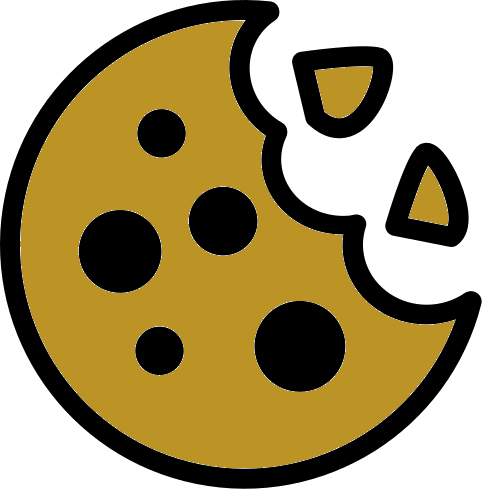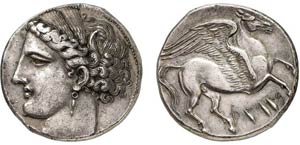- Startseite
- Numismatic Auction 8
- 22 Zeugitania - Carthage. 5 shekels, ca. 260 BC, uncertain ...
Los Nr. 22 - Numismatic Auction 8
Gebote
Beschreibung
Zeugitania - Carthage. 5 shekels, ca. 260 BC, uncertain mint in Sicily. Obv. Head of Tanit-Persephone left, wearing barley wreath and earring. Rev. Pegasus flying right; below, «b’rst» (in the Land) in Punic characters. Kraay/Hirmer 211; G.J. Jenkins, Coins of the Punic Sicily, part. IV, SNR 57, 1978, n° 442 (03/R11). AR 37.95 g.
Ch XF* Strike 5/5 Surface 5/5 NGC
Ex. Lanz auction 54, 12 november 1990, lot 358.
This exceptional silver decadrachm of Carthage was struck at the beginning of the war effort of the first Punic war against Rome. It was struck in Sicily using the traditional Punic standards and not the Attica standard, as used earlier in coins issued locally by the Carthaginians. The reverse shows Pegasus flying to the right and has no links with the Punic iconography. It is styled after Corinthian staters that were widely circulating in Sicily during the time, and which were resumed in Syracuse during the reign of Agathocles (317-289). Even the portrait on the obverse of Tanit-Persephone tends to be closer, in its particular style, to that of Arethusa. However, by its weight, general appearance as well as the striking technique, this Carthaginian “Decadrachm” is much different from those issued nearly a century and a half earlier in Sicily. Its low relief and the flat and thinner planchets used for these coins are clearly different than many of the other Greek coins of the time. Its style and quality makes this coin an emblematic part of Carthaginian numismatics, which alone perfectly illustrates the singularity and characteristics of the Punic style.
Cette exceptionnelle monnaie d’argent carthaginoise remonte aux débuts de l’effort financier causé par la première guerre punique contre Rome. Elle est frappée en Sicile selon l’étalon punique traditionnel et non plus attique, comme auparavant pour les monnaies émises sur place par les Carthaginois. Son type de revers, Pégase volant à droite, est sans lien avec l’iconographie punique. Il rappelle celui des très nombreux statères corinthiens qui circulent depuis longtemps en Sicile ; il est repris par Syracuse dès le règne d’Agathocle (317-289). Le portrait même de Tanit-Perséphone tend à se rapprocher, par ses attributs notamment, de celui d’Aréthuse. Cependant, tant par son poids, son aspect général, que par les techniques de sa frappe, ce « décadrachme » carthaginois ne ressemble guère à ses prédécesseurs émis près d’un siècle et demi plus tôt en Sicile. Son relief est bien plus bas car le flan employé est manifestement plus mince. Son module et ses spécificités en font une pièce emblématique de la numismatique carthaginoise, une pièce qui, à elle seule, illustre parfaitement la singularité si caractéristique du style punique.
Bitte melden Sie sich an, oder registrieren Sie sich für Ihren persönlichen Zugang.
Für weitere Informationen schreiben Sie uns an info@cfnumis.com
Kategorien
Auktion: Numismatic Auction 8
Auktionstermine
Vorgebote - Ende
04 07 2017 17:00 CEST
Saal-Auktion - Anfang
05 07 2017 15:00 CEST
Information
Kontakte
Avenue du Mail, 15, Genève, 1205, Schweiz
 Cookie-Richtlinie
Cookie-Richtlinie
Diese Website verwendet Cookies , um die Benutzererfahrung zu verbessern und Informationen über die Nutzung der Website zu sammeln. Sie können unsere Cookie-Richtlinie lesen, alle Cookies akzeptieren und fortfahren durch Klicken auf "Akzeptieren" oder Ihre Auswahl anpassen, indem Sie auf "Anpassen" klicken.
Cookie-Richtlinie
Cookies
Damit diese Website ordnungsgemäß funktioniert, installieren wir manchmal kleine Dateien namens " Cookies " auf Ihrem Gerät. Die meisten großen Websites tun dasselbe.
Was sind Cookies?
Ein Cookie ist eine kleine Textdatei, die Websites auf Ihrem Computer oder Mobilgerät speichern, während Sie sie besuchen. Dank Cookies merkt sich die Site Ihre Aktionen und Präferenzen (z. B. Login, Sprache, Schriftgröße und andere Anzeigeeinstellungen), sodass Sie diese nicht erneut eingeben müssen, wenn Sie zur Site zurückkehren oder von einer Seite zur anderen navigieren.
Wie verwenden wir Cookies?
Cookies von Drittanbietern
Google Analytics
Diese Website verwendet Google Analytics, um Informationen über die Nutzung der Website durch die Nutzer zu sammeln. Google Analytics generiert statistische und andere Informationen durch Cookies, die auf den Computern der Benutzer gespeichert werden. Die über unsere Website erzeugten Informationen werden verwendet, um Berichte über die Nutzung von Websites zu erstellen. Diese Informationen werden von Google gespeichert und verwendet. Die Datenschutzerklärung von Google ist unter folgender Adresse abrufbar: https://policies.google.com/privacy .
Es ist nicht erforderlich, Cookies zu aktivieren, damit die Website funktioniert, aber dies verbessert die Navigation. Es ist möglich, Cookies zu löschen oder zu blockieren, aber in diesem Fall können einige Funktionen der Website nicht richtig funktionieren.Die Informationen zu Cookies werden nicht verwendet, um Benutzer zu identifizieren, und die Navigationsdaten stehen immer unter unserer Kontrolle. Diese Cookies werden ausschließlich für die hier beschriebenen Zwecke verwendet.
So kontrollieren und ändern Sie Cookies?
Sie können Ihre Einwilligung jederzeit in der Cookie-Erklärung ändern oder widerrufen unsere Website.
Datenschutzerklärung
Erfahren Sie mehr darüber, wer wir sind, wie Sie uns kontaktieren können und wie wir personenbezogene Daten verarbeiten in unserer Datenschutzrichtlinie .
Die notwendigen Cookies helfen dabei, die Website nutzbar zu machen, indem sie grundlegende Funktionen wie Seitennavigation und Zugriff auf geschützte Bereiche der Website ermöglichen. Ohne diese Cookies kann die Website nicht richtig funktionieren.
| Name | Lieferant | Zweck | Ablauf |
|---|---|---|---|
| cookieConsent | bidinside | Speichert den Cookie-Zustimmungsstatus des Benutzers für die aktuelle Domäne | 6 Monate |
| PHPSESSID | bidinside | Bewahren Sie den Status des Benutzers auf den verschiedenen Seiten der Site auf. | Wenn die Browsersitzung endet |
| f_display | bidinside | Die f_display-Cookies speichern den vom Benutzer gewählten Anzeigemodus auf den Seiten mit Listen | Wenn die Browsersitzung endet |
| f_page | bidinside | Die f_page-Cookies speichern die vom Benutzer angezeigte Seite auf den Seiten, auf denen Listen vorhanden sind | Wenn die Browsersitzung endet |
| f_rec_page | bidinside | Die f_rec_page-Cookies speichern die Anzahl der Elemente, die pro vom Benutzer ausgewählter Seite auf den Seiten angezeigt werden sollen, auf denen Listen vorhanden sind | Wenn die Browsersitzung endet |
| f_order_by | bidinside | Die f_order_by-Cookies speichern die vom Benutzer ausgewählten Sortierparameter auf den Seiten, auf denen Listen vorhanden sind | Wenn die Browsersitzung endet |
| f_order_dir | bidinside | Die Cookies f_order_dir speichern die vom Benutzer gewählte Bestellrichtung auf den Seiten, auf denen Listen vorhanden sind | Wenn die Browsersitzung endet |
| watch_list_show_imgs | bidinside | Das Cookie watch_list_show_imgs speichert die Wahl des Benutzers, die Bilder der Lose auf der Merklistenseite anzuzeigen oder auszublenden | Wenn die Browsersitzung endet |
| selected_voice | bidinside | Das Cookie selected_voice speichert die vom Benutzer ausgewählte Stimme für die in der Live-Auktion vorhandene Sprachsynthese | 1 Monat |
| include_autobids | bidinside | Das Cookie include_autobids speichert die Wahl des Benutzers, seine auto-bid auf der Seite 'Ihre Gebote' anzuzeigen oder auszublenden | 6 Monate |
Analytische Cookies helfen zu verstehen, wie Besucher mit der Website interagieren, indem sie statistische Informationen sammeln und an den Datenverantwortlichen übermitteln.
| Name | Lieferant | Zweck | Ablauf |
|---|---|---|---|
| _ga | Registrieren Sie eine eindeutige ID, die verwendet wird, um statistische Daten darüber zu generieren, wie der Besucher die Website nutzt. | 2 Jahre | |
| _gat_gtag | Wird von Google Analytics verwendet, um die Häufigkeit von Anfragen zu begrenzen | 1 Tag | |
| _gat | Wird von Google Analytics verwendet, um die Häufigkeit von Anfragen zu begrenzen | 1 Tag | |
| _gid | Registrieren Sie eine eindeutige ID, die verwendet wird, um statistische Daten darüber zu generieren, wie der Besucher die Website nutzt. | 1 Tag | |
| __utma | bidinside | Wird verwendet, um Benutzer und Sitzungen zu unterscheiden. Das Cookie wird erstellt, wenn die Javascript-Bibliothek ausgeführt wird und keine vorhandenen __utma-Cookies vorhanden sind. Das Cookie wird jedes Mal aktualisiert, wenn Daten an Google Analytics gesendet werden. | 2 jahre |
| __utmt | bidinside | Wird verwendet, um die Anforderungsrate zu drosseln. | 10 minuten |
| __utmb | bidinside | Wird verwendet, um neue Sitzungen/Besuche zu bestimmen. Das Cookie wird erstellt, wenn die Javascript-Bibliothek ausgeführt wird und keine vorhandenen __utmb-Cookies vorhanden sind. Das Cookie wird jedes Mal aktualisiert, wenn Daten an Google Analytics gesendet werden. | 30 minuten |
| __utmc | bidinside | Wird in ga.js nicht verwendet. Auf Interoperabilität mit urchin.js eingestellt. In der Vergangenheit wurde dieses Cookie in Verbindung mit dem __utmb-Cookie verwendet, um festzustellen, ob sich der Benutzer in einer neuen Sitzung/einem neuen Besuch befand. | Wenn die Browsersitzung endet |
| __utmz | bidinside | Speichert die Zugriffsquelle oder Kampagne, die erklärt, wie der Benutzer auf Ihre Website gelangt ist. Das Cookie wird erstellt, wenn die JavaScript-Bibliothek ausgeführt wird, und wird jedes Mal aktualisiert, wenn Daten an Google Analytics gesendet werden. | 6 monate |
| __utmv | bidinside | Wird verwendet, um benutzerdefinierte variable Daten auf Besucherebene zu speichern. Dieses Cookie wird erstellt, wenn ein Entwickler die Methode _setCustomVar mit einer benutzerdefinierten Variablen auf Besucherebene verwendet. Dieses Cookie wurde auch für die veraltete Methode _setVar verwendet. Das Cookie wird jedes Mal aktualisiert, wenn Daten an Google Analytics gesendet werden. | 2 jahre |
Präferenz- / technische Cookies ermöglichen einer Website, sich an Informationen zu erinnern, die das Verhalten oder die Darstellung der Website beeinflussen, wie z. B. Ihre bevorzugte Sprache oder die Region, in der Sie sich befinden.
Wir verwenden keine Cookies dieser Art.Profiling-Cookies werden für Marketingzwecke verwendet, um Website-Besucher zu überwachen. Die Absicht besteht darin, relevante und ansprechende Anzeigen für den einzelnen Benutzer anzuzeigen.
Wir verwenden keine Cookies dieser Art.Nicht klassifizierte Cookies sind Cookies, die zusammen mit einzelnen Cookie-Anbietern klassifiziert werden.
Wir verwenden keine Cookies dieser Art.




 23
23